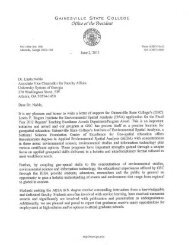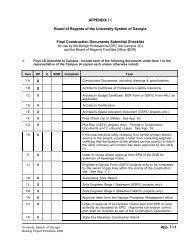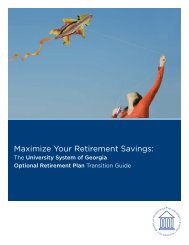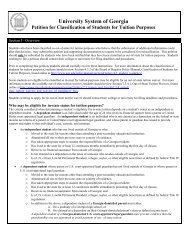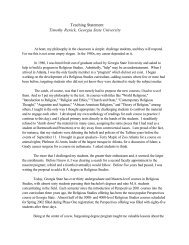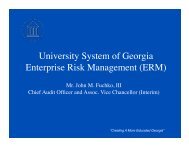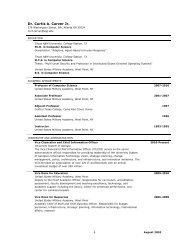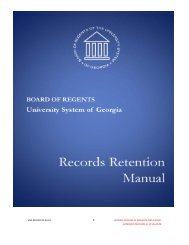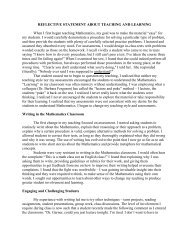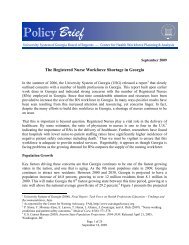66884 Federal Register / Vol. 75, No. 209 / Friday, October 29, 2010 / Rules and RegulationsWReier-Aviles on DSKGBLS3C1PROD with RULES2category when measuring pace towardscompletion for each SAP evaluationperiod.Changes: None.Comment: One commenterrecommended that the <strong>Department</strong>revise § 668.34(a) to require transfercredits to be considered whendetermining progress towards maximumtimeframe, but not for purposes <strong>of</strong>determining the pace <strong>of</strong> completion foreach evaluation period. This commenterstated that counting transfer creditswhen looking at each evaluation periodwould give transfer students an unfairadvantage in the pace to completioncalculation.Another commenter noted that thepractice <strong>of</strong> excluding courses that werenot degree applicable from the pacecalculation for evaluating SAP hasprompted many students to changemajors in order to retain financial aideligibility. The commenter opined thatthis practice leaves the door open toabuse <strong>of</strong> the system. Additionally, thecommenter stated that the <strong>Department</strong>should require that all courses that thestudent had attempted and completed inhis entire career be included in the pacecomputation for purposes <strong>of</strong>determining the student’s progresstoward program completion.Discussion: The <strong>Department</strong>acknowledges that transfer students mayhave a slight advantage over otherstudents when an institution calculatestheir pace toward program completion.However, this inclusion <strong>of</strong> transfercredits in the calculation <strong>of</strong> pace willallow for a more level playing field forall students, and standardize treatment<strong>of</strong> completed credits in the SAPevaluation. This is because includingtransfer credits in the calculation <strong>of</strong>pace means we are considering allcompleted work for all students.We also note that the <strong>Department</strong> hashad a longstanding policy thatinstitutions are free to set their own SAPpolicy that deals with major changes asthey relate to measurement <strong>of</strong> maximumtimeframe. Therefore, if an institutionwishes to limit the number <strong>of</strong> majorchanges that it will allow a student,then it is free to set a policy that doesso.Changes: None.Financial Aid Probation and FinancialAid Warning StatusesComment: Many commenters foundthe definitions <strong>of</strong> the terms financial aidwarning and financial aid probation inproposed § 668.34(b) to be helpful.These commenters stated that it wasvery useful to have standard vocabularyto use when discussing SAP. Somecommenters noted that these terms andconcepts matched their current policywhile others requested slight changes tothe terms or definitions so that theyalign more closely with their owninstitution’s policies. Severalcommenters sought clarification,however, as to whether institutions arerequired under these regulations to usethe newly defined terms <strong>of</strong> financial aidwarning and financial aid probation intheir consumer information and othercommunications with students, orwhether we would allow them tocontinue to use their currentterminology. These commentersexpressed concern that their studentsmight be confused if they changed theterminology used in this area.Discussion: The <strong>Department</strong> intendsto allow institutions to have as muchflexibility as possible in developing anappropriate SAP policy for theirinstitution as well as consumerinformation materials for their students.However, institutions must incorporatethese regulations changes into theinformation that they provide tostudents; this includes ensuring that theinformation made available by theinstitution uses the terminology used inthese regulations.Changes: None.Comment: Several commentersexpressed support for the addition <strong>of</strong>the concept <strong>of</strong> a financial aid warningstatus, but believed that the use <strong>of</strong> thisstatus should be available to allinstitutions, regardless <strong>of</strong> how <strong>of</strong>tenthey performed a SAP evaluation. Some<strong>of</strong> the commenters asserted that thiswould allow institutions additionalflexibility in administering SAP thatwould be beneficial for students. Somecommenters also noted that it would bean administrative burden to reviewstudents more frequently. Othersindicated that they had stable studentpopulations and did not need toevaluate more <strong>of</strong>ten than annually. Atleast one commenter opined thatschools with good graduation andcompletion rates should be able to usethe financial aid warning statusregardless <strong>of</strong> how <strong>of</strong>ten they checkedSAP. Some commenters argued that thefinancial aid warning status should bean option for all institutions to useautomatically and without intervention,and for periods as long as a year or untilthe next scheduled evaluation. Onecommenter suggested that in exchangefor allowing all institutions to use thefinancial aid warning status regardless<strong>of</strong> how <strong>of</strong>ten they evaluate students’academic progress, institutions shouldbe required to remind students <strong>of</strong> theirSAP standards at the end <strong>of</strong> anypayment period in which an evaluationis not done. Some commenters wantedVerDate Mar2010 14:10 Oct 28, 2010 Jkt 223001 PO 00000 Frm 00054 Fmt 4701 Sfmt 4700 E:\FR\FM\29OCR2.SGM 29OCR2to know if the financial aid warningstatus could be used to evaluate astudent’s progress and to help toprepare an academic plan and appealfor the student, so that the studentwould not suffer a lapse in eligibility.Discussion: While we appreciate thefact that institutions support theflexibility that the financial aid warningstatus provides, the <strong>Department</strong> feelsstrongly that this option should only beavailable when an institution evaluatesSAP each payment period. It isimportant to remember that a studentwho is on a financial aid warning statusis one who is not actually meeting SAPstandards.If an institution has a stable studentpopulation and does not believe it needsto evaluate SAP each payment period,then it is not required to do so. Werecognize that there is an additionaladministrative burden involved forinstitutions to evaluate every paymentperiod, but we also believe studentsbenefit from the early intervention <strong>of</strong>this approach. We believe that thisapproach will impact favorably onstudent completion rates, as well ashelp minimize student debt levels forthose that are not on track to completea program successfully. We note that,during the negotiated rulemakingprocess, several negotiators had a SAPpolicy that required checking astudent’s academic progress eachpayment period. These negotiatorsrelated numerous student successstories that resulted from earlyintervention. This demonstrated successwith this approach led to the negotiatorssupporting the proposed SAPregulations.We believe that it is important to getstudents back on track as soon aspossible, and not allow the continuedprovision <strong>of</strong> title IV, HEA aid tostudents who are not making progresstowards program completion under theinstitution’s SAP standards. Allowing afinancial aid warning status for onepayment period allows the institution toprovide an alert to that student <strong>of</strong> hisstatus, as well as provide any neededsupport services. The institution coulduse the time to meet with the studentand, if the situation means that anappeal will be necessary, to help thestudent prepare that appeal or toprepare an academic plan. The samebenefit is not realized if the studentsimply receives notice <strong>of</strong> theinstitution’s SAP policy, as he may notunderstand his individual status withregards to the policy.Changes: None.Comment: Several commentersexpressed support for the financial aidwarning and financial aid probation
Federal Register / Vol. 75, No. 209 / Friday, October 29, 2010 / Rules and Regulations66885WReier-Aviles on DSKGBLS3C1PROD with RULES2statuses proposed in § 668.34, butrequested that the <strong>Department</strong> add tothe SAP regulations a defined term fora student who has lost eligibility for titleIV, HEA aid as a result <strong>of</strong> aninstitution’s evaluation under the SAPregulations. Several other commentersquestioned what status would beassigned to a student who wasreinstated on an academic plan and wasmaking progress under that plan. Thesecommenters wondered whether theseindividuals would still be considered tobe on financial aid probation status, orif the <strong>Department</strong> planned to defineanother term to refer to them.Discussion: A student who is notmeeting SAP is simply not eligible toreceive title IV, HEA aid, as he or shedoes not meet one <strong>of</strong> the basic studenteligibility criteria. For this reason, wedo not believe it is necessary to defineanother term to describe this individual,just as we do not have specific terms todescribe students who may not bemeeting other basic student eligibilitycriteria.A student who has been reinstated toeligibility under an academic plan andis making progress under that plan isconsidered to be an eligible student. Thestudent is not considered to be onfinancial aid warning status or financialprobation status, provided he or she isotherwise making satisfactory progress.Changes: None.Comment: A few commenters arguedthat proposed § 668.34(c) could beinterpreted to allow an institution toplace a student on financial aid warningstatus for more than one paymentperiod, and that, under thisinterpretation, the student would beable to get title IV, HEA aid for multiplepayment periods when the student is onfinancial aid warning status as long asthe student was within range <strong>of</strong> movinginto compliance with the institution’sSAP standards. These commentersstated that the language in § 668.34(c)does not need to be interpreted sonarrowly so as to limit the number <strong>of</strong>payment periods during which astudent could be placed on financial aidstatus to one payment period.Other commenters suggested thatstudents could develop and follow anacademic plan during the period <strong>of</strong> theirfinancial aid warning and that thisapproach would allow for students to beput on financial aid warning status formultiple periods. These commenters allopined that there was a range <strong>of</strong>deficiencies within any category <strong>of</strong>student failure, and that students mayrequire differing amounts <strong>of</strong>intervention to get back on track to meetthe institution’s SAP standards. Thecommenters stated that institutionsshould be able to define different bands<strong>of</strong> need for assigning financial aidwarning statuses. Several othercommenters requested that the<strong>Department</strong> clarify that students may beplaced on financial aid warning orfinancial aid status for multiplepayment periods throughout theiracademic careers.Other commenters asked the<strong>Department</strong> to clarify whether therequirements around financial aidwarning or financial aid probationarystatuses allow students to receive titleIV, HEA aid for more than one paymentperiod. One commenter indicated thatlack <strong>of</strong> financial aid during a period inwhich the student is on financial aidprobationary status would causeproblems for students. The commenterstated that this would cause barriers forthe most needy and at-risk students.Discussion: The financial aid warningstatus and the financial aid probationarystatus are both defined in § 668.34(b). Astudent who has not made satisfactoryacademic progress and is placed underone <strong>of</strong> these statuses may continue toreceive title, IV HEA aid for onepayment period only, under veryspecific circumstances. We do notintend for the language in § 668.34(b) tobe interpreted in any other fashion. Torespond to the commenter who believedthat lack <strong>of</strong> financial support during thisperiod would disadvantage students, itis important to note that both <strong>of</strong> thesestatuses provide for one payment period<strong>of</strong> title IV, HEA funds. It is possible forinstitutions that are able to use thefinancial aid warning status to do anysort <strong>of</strong> intervention with a student thatthey deem appropriate during theperiod <strong>of</strong> time the student is in thatstatus, including help them to preparean appeal or refer them to other studentsupport services. We do not believe thatit is appropriate, however, to continueplacing students on a financial aidwarning status for more than onepayment period because these arestudents who are not making progresstoward program completion. We do notbelieve it is appropriate to put thestudent on an academic plan and simplycontinue such a plan without anappropriate appeal. This is because webelieve that a student should berequired to file an appeal and explainthe reason that he or she has not beenable to meet the SAP standards, andwhat in his or her situation haschanged. It is important for the studentto have ownership in his or her currentsituation and the resulting academicplan, with an understanding <strong>of</strong> theconsequences the student faces if he orshe fails to follow the academic plan.We do agree with the commenters whoVerDate Mar2010 14:10 Oct 28, 2010 Jkt 223001 PO 00000 Frm 00055 Fmt 4701 Sfmt 4700 E:\FR\FM\29OCR2.SGM 29OCR2suggest that it is possible for a studentto be subject to more than one period <strong>of</strong>financial aid warning, or to submit morethan one appeal throughout anacademic career, if the institution’s SAPpolicy allows it.Changes: None.Comment: Numerous commentersobjected to the requirement in theproposed regulations for institutions tocheck SAP on a payment period-bypaymentperiod basis. They argued thatit is unreasonable for the <strong>Department</strong> toimpose such a requirement oninstitutions that do not have any history<strong>of</strong> abuse in this area and that otherwisehave good SAP policies. Thesecommenters noted that it would beoverly burdensome to requireinstitutions to change their SAPprocedures to require SAP evaluationsevery payment period.Discussion: Section 668.34(a)(3) isconsistent with current§ 668.16(e)(2)(ii)(B), which requiresinstitutions to check academic progressfor programs that are longer than anacademic year at least annually. Whileinstitutions can check academicprogress for these programs morefrequently, they are not required to doso. Under these regulations, institutionsare only required to evaluate satisfactoryacademic progress more frequently ifthe program is shorter than an academicyear.Changes: None.Comment: A couple <strong>of</strong> commentersasked the <strong>Department</strong> to confirm thatthe financial aid warning and financialaid probation status would be applied tothe student’s next payment period(following the institution’sdetermination that the student is notmaintaining SAP) and not simply to thenext payment period at the institution.These commenters argued that it wasimportant to apply the status to thestudent during the next term that thestudent was actually in attendance.One commenter believed that aprogram <strong>of</strong> an academic year in lengthor shorter should not be allowed to usethe financial aid warning status becausea student in such a program wouldnever be denied title IV, HEA funds fornot making SAP.Discussion: Under these regulations,an institution would apply the financialaid warning or financial aid probationstatus to a student during the student’snext period <strong>of</strong> attendance. It is notreasonable to assume that the studentwould be considered to be on financialaid warning, for example, if he or shewere not in attendance. For shorterprograms (i.e., those that are anacademic year or less), the definition <strong>of</strong>a payment period does not allow
- Page 1 and 2:
Friday,October 29, 2010Part IIDepar
- Page 3 and 4: Federal Register / Vol. 75, No. 209
- Page 6 and 7: 66836 Federal Register / Vol. 75, N
- Page 8 and 9: 66838 Federal Register / Vol. 75, N
- Page 10 and 11: WReier-Aviles on DSKGBLS3C1PROD wit
- Page 12 and 13: 66842 Federal Register / Vol. 75, N
- Page 14 and 15: 66844 Federal Register / Vol. 75, N
- Page 16 and 17: WReier-Aviles on DSKGBLS3C1PROD wit
- Page 18 and 19: 66848 Federal Register / Vol. 75, N
- Page 20 and 21: 66850 Federal Register / Vol. 75, N
- Page 22 and 23: WReier-Aviles on DSKGBLS3C1PROD wit
- Page 24 and 25: 66854 Federal Register / Vol. 75, N
- Page 26 and 27: WReier-Aviles on DSKGBLS3C1PROD wit
- Page 28 and 29: 66858 Federal Register / Vol. 75, N
- Page 30 and 31: 66860 Federal Register / Vol. 75, N
- Page 32 and 33: 66862 Federal Register / Vol. 75, N
- Page 34 and 35: 66864 Federal Register / Vol. 75, N
- Page 36 and 37: 66866 Federal Register / Vol. 75, N
- Page 38 and 39: WReier-Aviles on DSKGBLS3C1PROD wit
- Page 40 and 41: WReier-Aviles on DSKGBLS3C1PROD wit
- Page 42 and 43: 66872 Federal Register / Vol. 75, N
- Page 44 and 45: WReier-Aviles on DSKGBLS3C1PROD wit
- Page 46 and 47: WReier-Aviles on DSKGBLS3C1PROD wit
- Page 48 and 49: WReier-Aviles on DSKGBLS3C1PROD wit
- Page 50 and 51: 66880 Federal Register / Vol. 75, N
- Page 52 and 53: WReier-Aviles on DSKGBLS3C1PROD wit
- Page 56 and 57: 66886 Federal Register / Vol. 75, N
- Page 58 and 59: WReier-Aviles on DSKGBLS3C1PROD wit
- Page 60 and 61: WReier-Aviles on DSKGBLS3C1PROD wit
- Page 62 and 63: WReier-Aviles on DSKGBLS3C1PROD wit
- Page 64 and 65: WReier-Aviles on DSKGBLS3C1PROD wit
- Page 66 and 67: WReier-Aviles on DSKGBLS3C1PROD wit
- Page 68 and 69: WReier-Aviles on DSKGBLS3C1PROD wit
- Page 70 and 71: WReier-Aviles on DSKGBLS3C1PROD wit
- Page 72 and 73: 66902 Federal Register / Vol. 75, N
- Page 74 and 75: WReier-Aviles on DSKGBLS3C1PROD wit
- Page 76 and 77: WReier-Aviles on DSKGBLS3C1PROD wit
- Page 78 and 79: 66908 Federal Register / Vol. 75, N
- Page 80 and 81: WReier-Aviles on DSKGBLS3C1PROD wit
- Page 82 and 83: 66912 Federal Register / Vol. 75, N
- Page 84 and 85: WReier-Aviles on DSKGBLS3C1PROD wit
- Page 86 and 87: 66916 Federal Register / Vol. 75, N
- Page 88 and 89: WReier-Aviles on DSKGBLS3C1PROD wit
- Page 90 and 91: WReier-Aviles on DSKGBLS3C1PROD wit
- Page 92 and 93: WReier-Aviles on DSKGBLS3C1PROD wit
- Page 94 and 95: 66924 Federal Register / Vol. 75, N
- Page 96 and 97: WReier-Aviles on DSKGBLS3C1PROD wit
- Page 98 and 99: 66928 Federal Register / Vol. 75, N
- Page 100 and 101: WReier-Aviles on DSKGBLS3C1PROD wit
- Page 102 and 103: 66932 Federal Register / Vol. 75, N
- Page 104 and 105:
WReier-Aviles on DSKGBLS3C1PROD wit
- Page 106 and 107:
66936 Federal Register / Vol. 75, N
- Page 108 and 109:
66938 Federal Register / Vol. 75, N
- Page 110 and 111:
66940 Federal Register / Vol. 75, N
- Page 112 and 113:
66942 Federal Register / Vol. 75, N
- Page 114 and 115:
66944 Federal Register / Vol. 75, N
- Page 116 and 117:
66946 Federal Register / Vol. 75, N
- Page 118 and 119:
WReier-Aviles on DSKGBLS3C1PROD wit
- Page 120 and 121:
WReier-Aviles on DSKGBLS3C1PROD wit
- Page 122 and 123:
WReier-Aviles on DSKGBLS3C1PROD wit
- Page 124 and 125:
66954 Federal Register / Vol. 75, N
- Page 126 and 127:
WReier-Aviles on DSKGBLS3C1PROD wit
- Page 128 and 129:
66958 Federal Register / Vol. 75, N
- Page 130 and 131:
66960 Federal Register / Vol. 75, N
- Page 132 and 133:
WReier-Aviles on DSKGBLS3C1PROD wit
- Page 134 and 135:
WReier-Aviles on DSKGBLS3C1PROD wit
- Page 136 and 137:
WReier-Aviles on DSKGBLS3C1PROD wit
- Page 138 and 139:
66968 Federal Register / Vol. 75, N
- Page 140 and 141:
66970 Federal Register / Vol. 75, N
- Page 142 and 143:
66972 Federal Register / Vol. 75, N
- Page 144 and 145:
66974 Federal Register / Vol. 75, N



